In this article, you’ll learn what is a supercharger? How does it work? Types of Superchargers, advantages, and disadvantages.
Also, you can download the PDF file of this article at the end.
What is a Supercharger?
A supercharger is a mechanically driven component that uses an air compressor or blower to pressurize the air being pumped into the intake manifold. But do you know the turbo does the same work as superchargers do?
Turbos are other types of superchargers and were originally known as turbosuperchargers. These days we use the name superchargers for engine air-compressor that aren’t turbos.
Definition
A Supercharger is a device that increases the pressure of the air-fuel mixture from the carburetor before it enters the engine. Supplying the air-fuel mixture to the engine above the atmospheric pressure is called supercharging.
In an un-supercharged engine, the cylinder draws the mixture equal to its displacement volume. It is connected between the carburetor and the cylinder through the intake manifold. The engine usually drives it through suitable gears and shafts.
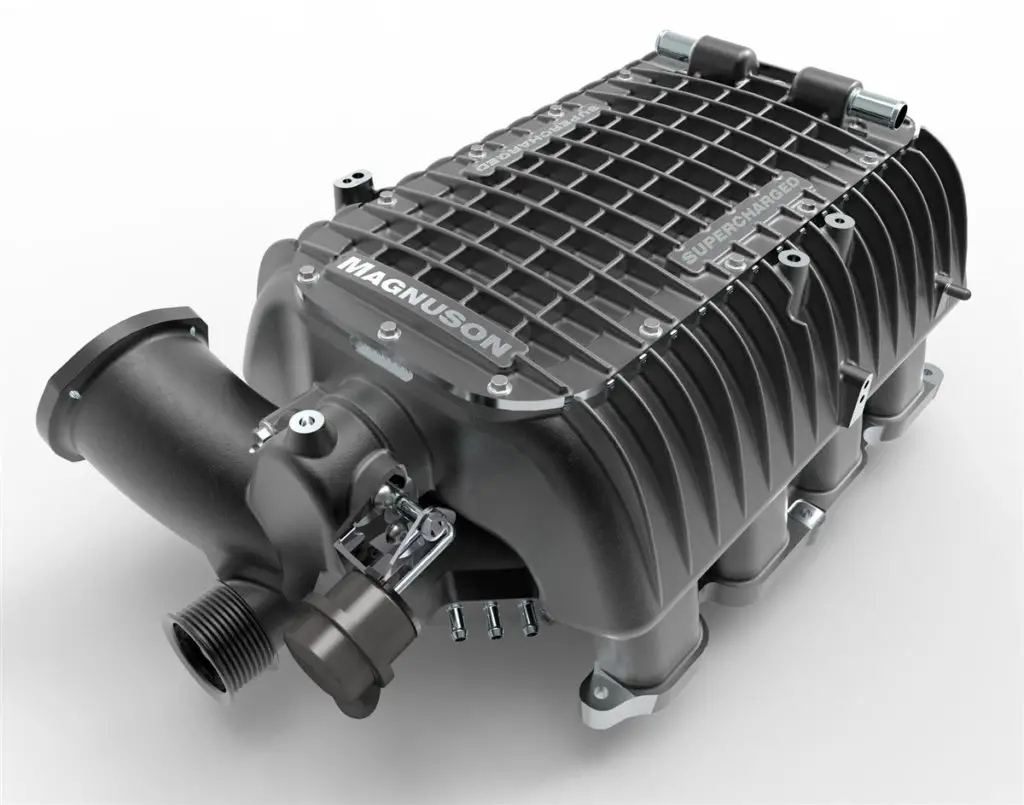
How are The Superchargers Invented?
Since the invention of the internal combustion engine( IC engine), automotive engineers and race car designers have been searching for new ways to boost engine power and make it faster.
One way is to build a bigger engine to add more power. But bigger engines mean more weight and cost to build and maintain, and they are not always better. Another way to add power is to make a normal-sized engine more efficient. This can be done by forcing more air into the combustion chamber.
More air means more fuel can be added, which means a bigger explosion and greater horsepower. Adding a supercharger is a great way to achieve forced air induction.
Read also: Basic Engine Components (Names and Pictures)
Types of Superchargers
Following are the types of superchargers used in vehicles:
- Centrifugal type supercharger.
- Vane-type supercharger.
- Roots air-blower type supercharger.
#1 Centrifugal Type Supercharger
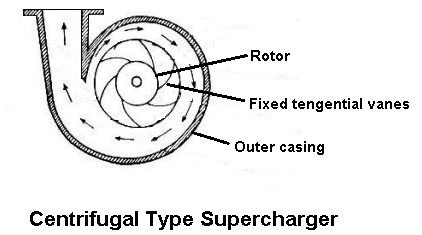
It consists of an impeller that rotates at a very high speed, about 10,000 r.p.m. The air-fuel mixture enters the impeller at the center and, after passing through the impeller and diffuser vanes, goes out of the casing to the engine cylinder. Due to the high speed of the impeller, the mixture was forced into the cylinder at high pressure.
#2 Roots Air-Blower Type Supercharger
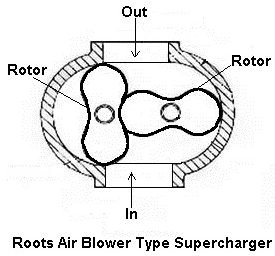
It consists of two rotors of the epicycloid shape. Each rotor is fixed to a shaft by a key. The two shafts are connected through gears of equal size.
Thus, the two rotors revolve at the same speed. The working action of such a supercharger is just like a gear pump so that the mixture at the outlet side is at high pressure.
#3 Vane Type Supercharger
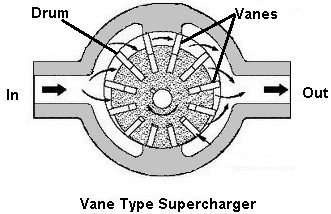
It consists of a drum on which several vanes are mounted to slide in or out against some force. This keeps them constantly in contact with the interior of the supercharger body.
The space between the body and the drum decreases from the inlet to the outlet side. Thus, the air-fuel mixture entrapped between any two vanes at the inlet goes in decreasing volume and increasing in pressure as it reaches the outlet.
The roots supercharger is simpler in construction and requires the least maintenance. It has a comparatively longer life. It works well even at lower speed ranges. Centrifugal-type supercharger has poor working characteristics at lower speeds. The vane-type supercharger has the problem of wear of vane tips.
You might like: Understand The Working of Single Cylinder Engine
Working of Supercharger
The air draws into an impeller, and centrifugal force throw it out in a compressor housing where the speed gets compressed in a high pressure instead—more air, more gas, and more power.
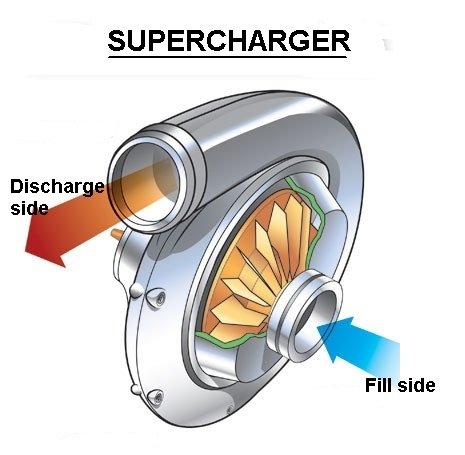
The pressure inside the cylinders is less than the atmospheric pressure during the suction stroke. But in a supercharged engine, the mixture is forced into the cylinder at a pressure higher than the atmosphere.
Due to the higher pressure, the density of the mixture increases. Therefore, its weight per stroke is increased for the same displacement volume. It increases the power output of the engine. The rate of fuel consumption is also increased.
- The engine should be able to take higher forces due to supercharging.
- Also, the fuel used should have higher anti-knock characteristics.
It should be noted that supercharging increases the weight or density of air-fuel mixture (in spark-ignition engines) or air (in compression ignition engines) sucked into that cylinder during the suction stroke.
Supercharging decreases the knock tendencies in compression ignition engines. The take-off by heavily loaded aircraft, the quicker rate of climb, and high altitude performance can be achieved to the same extent by supercharging.
To better understand how superchargers work, watch this video:
You might like: What is the function of Engine Valves? Types & Working [Explained]
Applications of Superchargers
The following are the applications of superchargers:
- Supercharging reduces the weight per horsepower of the engines as required in aero engines.
- To reduce the space occupied by the engine as necessitated in marine engines.
- To maintain the power of a reciprocating aircraft engine even at high altitudes where less oxygen is available for combustion.
- It is used to improve the volumetric efficiency of the engine at high altitudes, as in aero engines, and at high speeds, as in racing cars.
- To have better turbulence and thus ensures complete combustion giving greater power and low specific fuel consumption.
Advantages and Disadvantages of Superchargers
Advantages:
- By adding superchargers, you’ll have good low-rpm boosts.
- They are reliable and fairly inexpensive.
- Superchargers do not use engine oil, so that’s the plus.
- You don’t have the heat issues a turbocharger has, so that’s a good thing.
Disadvantages:
- The problem with the types of root superchargers is it does not compress the air internally. It does cradle of heat. That’s one downside.
- All superchargers are powered by the engine rather than the exhaust gases. So to power the supercharger, a little bit of engine power is used. So you’ll have a loss just by having a supercharger on there.
- Superchargers have a high-weight placement. So you’ve got your engine, and then the supercharger will be placed on top.
Conclusion
That’s it. Thanks for reading. If you have any questions or doubts on “types of superchargers,” ask in the comment section. If you found this post helpful, share it with your friends.
Download the PDF version of this article by clicking below:
Subscribe to our newsletter to get notifications of our posts
Hey, if you like to read more on superchargers, then follow these links:
- https://www.sciencedirect.com/topics/engineering/superchargers
- https://www.britannica.com/technology/supercharger
Read More on Our Blog
- Different types of tires
- Difference Between Internal and External Combustion Engine
- Suspension System: Types, Parts, Working, and More
- How Does A Fuel Injection System Work?
- Understand The Different Types of Power Steering Systems
- Everything You Should Know About The Starter Motor
- What is Timing Belt In a Car? Why is it Important?
- What is Distributorless Ignition System?
Frequently Asked Questions
Superchargers are pumps, compressors, or blowers that are mechanically, electrically, or hydraulically powered. They are used to increase the pressure of the intake charge mixture in spark-ignited engines or the charge air in diesel engines.
There are three main types of superchargers commonly used in automotive applications: Roots Type, Vane Type, and Centrifugal Type Superchargers.
Supercharging boosts an engine’s power without increasing fuel consumption. The engine uses some power to compress the air, but its overall power output is higher. The engine used with a supercharger has been designed to withstand greater forces.
Superchargers’ biggest drawback is that they drain engine power to produce engine power. Since they are powered by an engine belt fixed to the crankshaft, it is like using another air pump to power the first one.
Thanks for all this effort and work you’ve done, And thanks for telling it so well and so easy to understand!